(879 products available)





















































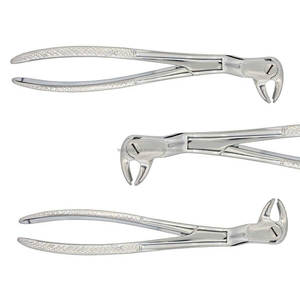
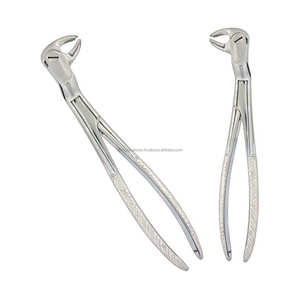
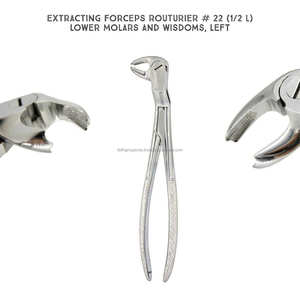
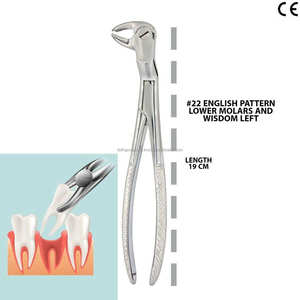
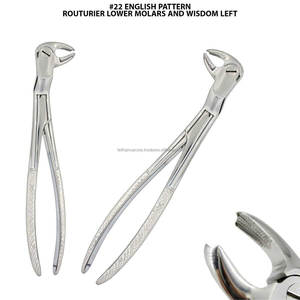
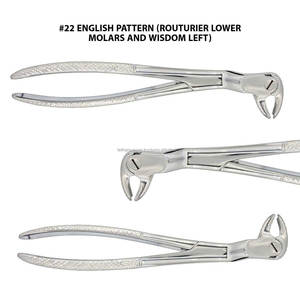


































































































































Wisdom teeth extracting forceps comprise several parts, including the handle, head, and jaws, with each part serving a distinct purpose. Suppliers offer different types of forceps based on the orientation and positioning of the tooth. For instance, upper forces have curved jaws, while lower ones tend to have pointed ones. There are also general types that practitioners can use for all wisdom teeth, regardless of direction, such as mesioangular, vertical, and horizontal.
Here's a list of the common types of forceps for wisdom teeth extractions:
Upper wisdom teeth extracting forceps
Upper dental practitioners use these forceps for wisdom teeth, which have a more curved shape because the upper teeth are rounder and have a different root structure from the lower ones. The jaws of these forceps are designed to grip the crown of the upper wisdom tooth securely, decreasing the risk of slipping or breaking the tooth during extraction. The handle is angled at around 90 degrees from the working end and is comfortable to hold and use.
Lower wisdom teeth extracting forceps
The lower wisdom teeth extracting forceps are a bit different. These forceps have a more horizontal, straight design due to the shape and position of the lower molars. The jaws are more pointed and grooved to fit the angular root system of lower wisdom teeth. The grip has a broader, flat design that helps provide the extra force needed for removing lower teeth which are often larger and more difficult to extract.
Universal wisdom teeth extracting forceps
Universal wisdom teeth extracting forceps are designed for both upper and lower extractions, regardless of the teeth's orientation. These forceps have a more neutral jaw shape that can accommodate various tooth positions. The design blends features from both upper and lower forceps, allowing practitioners to grip different types of wisdom teeth effectively. This versatility is helpful in cases where a physician must perform multiple extractions.
Mesioangular wisdom teeth extracting forceps
Mesioangular wisdom teeth extracting forceps are for teeth that lie at an angle to the front of the mouth. One jaw has a groove that fits into the tooth's root while the other has a bump to fit over the tooth. This design helps grab angled teeth firmly. The handle is designed to turn the tool easily to help remove mesioangular teeth from the back of the mouth.
Horizontal wisdom teeth extracting forceps
Horizontal wisdom teeth extracting forceps work for teeth that lie flat in the jaw. One jaw has a smooth surface and the other a grooved area that locks with the tooth. The handle lets the user pull straight without twisting. This design keeps pulls powerful while steadying any sideways movement on the grooved jaw.
Alibaba.com has suppliers who sell forceps in bulk and provides buyers with several designs. So there are types based on their purpose (surgical and nonsurgical) and materials (stainless steel, titanium, and carbon steel). Other forceps differ based on a locking mechanism. Some manufacturers have also started making forceps with ergonomic designs to reduce strain on dental practitioners, especially when they have to do multiple extractions.
Cross-action forceps
Cross-action forceps have angled jaw parts that cross over each other and pull in when the handles are squeezed. The design creates steady, even pressure that helps remove teeth straight out without twisting. This makes them especially helpful for hard teeth, like impacted wisdom ones. The crossed jaws give a strong grip on the tooth so it does not slip while also letting the dentist work smoothly from different angles.
Ergonomic grip
Many dental forceps now have handles shaped to fit how the hand grips naturally. This helps after a lot of pulling since there is no tight squeezing or rubbing. The special design spreads the force out, which eases tension on fingers, wrists, and joints. Dentists can extract teeth longer without fatigue. Less stress lets them work precisely without strain, too.
Locking mechanism
Some modern tooth forceps have special clasps that let one jaw latch onto the other tightly. Working this lock takes less effort than gripping tight by hand. The lock holds firmly with little pressure so dentists do not tire out during tough pulls. This helps when pulling large molars or multiple teeth from the location with less strain on the wrist and fingers.
Ratchet mechanism
These forceps have a built-in racheting system, which permits one handle to click into levels on the other. This lets dentists tighten the grip steadily in small amounts without constantly squeezing hard. It is useful during difficult extractions since the patient does not feel jolts if tiny adjustments are needed. The clicking ratchet controls tension gently, which reduces fatigue for complex pulls taking longer.
Fibre-reinforced composites
Some newer dental extraction forceps use sturdy plastic-like materials with tiny fibres instead of metal. These composites are very light, which reduces pulling strain on hands. They are strong enough for taking out teeth but more flexible in how the grip pads against the tooth surface. It feels more comfortable than heavy metal tools.
There are many cases wherewisdom forceps come in handy. Here are some of the most common scenarios:
Oral surgery practices
Dental forceps are vital tools oral surgery practices use to take out troublesome wisdom teeth safely. These forceps have special jaws that grasp and guide the tooth roots during tricky extractions. The practice stocks various upper and lower forceps tailored for the tooth's position. Surgeons might pick cross-action or ergonomic designs for hard pulls. Ratcheting and locking forceps can ease the strain during long surgeries. Strong, precise grips give the surgeon control and comfort while ensuring clean, careful removals.
Dental hospitals
Hospitals rely on sturdy, reliable forceps. They choose stainless steel or titanium ones that withstand many extractions. Access to locks and ratchets helps share the strain. When pulling large teeth, forceps let another staff member assist with steady pulls. Hospitals keep lots of different forceps on hand, too, since wisdom teeth vary in position. Having the right grip type ensures all removals go smoothly, which is good for patient safety and success.
Mobile dental clinics
Mobile clinics use light, easy-to-carry forceps since space is tight. Fibre-composite ones are very portable and reduce pulling strain on their hands. Ratcheting forceps work well, letting small adjustments happen smoothly. These tools make extractions safer for patients, even if the mobile unit moves from site to site.
Dental education centers
Dental students require different forceps practising extractions. Each type shows how grips vary for angled or impacted teeth. Students learn about locking, ratcheting, and ergonomic designs, which prepare them for future careers. Choosing the right wisdom tooth forceps for the job makes extractions safer in practice and real life.
Referral-based practices
Referral-based practices find forceps with locks and ratchets vital when general dentists send patients for extraction with difficult wisdom teeth. These forceps ensure safe, steady pulls when complex cases arise. Referral practices pick upper and lower forceps suited to the tooth's position. Having precise, controlled grips reduces strain on the dentist, which enables multi-extraction enduring-sessions.
Buyers should consider the following when purchasing dental extraction forceps:
Material
Practitioners prefer durable materials, such as titanium, stainless steel, or carbon, for forceps used to remove wisdom teeth. They choose titanium because it is super strong but still lightweight. They also like stainless steel because it holds up well and is cheap. Sometimes, they select carbon steel because it is very sharp but needs careful washing.
Tooth position
Specials, like upper or lower forceps, help pull wisdom teeth better by matching their shape to the tooth. General dental forceps work for any tooth, though. Mesioangular, vertical, and horizontal forceps have special designs that help with twisting pulls.
Grip type
Cross-action forceps pull more straight out without twisting, which is great for difficult teeth. Other types, like working end locking forceps, are designed to pull the tooth out with less effort.
Ergonomics
The forcep designs help dentists grip them comfortably for a long time without tiring out their hands. This is helpful in long surgeries.
Maintenance
Forceps that are easy to wash and take care of last much longer and stay safer for patients.
Forceps help remove wisdom teeth easily. Their special design grips the tooth firmly and guides it securely as it comes out. Their shape reduces pulling, twisting, or damaging nearby teeth. This makes extractions faster, easier, and safer during surgeries.
There are various sizes of extraction forceps for different teeth and mouths. Smaller ones work well for tiny or hard-to-reach teeth, while larger forceps are suitable for big molars.
Buyers should ensure their forceps are completely dry, and they should put a thin layer of oil on them. Then, they should store the forceps in a case that protects them but is not airtight so moisture and air can flow a little inside to prevent rust.
If one cares for them well, forceps can last a decade or more. Washing carefully after each use protects them. Storing the forceps dry keeps rust away. Limiting exposure to acidic dental products ensures the metal stays strong. With this maintenance, the forceps endure for a long time.
Dental practitioners should not use forceps that are broken, bent, or worn down because this could make teeth come out unevenly. Poorly gripped teeth might break. It is important to ensure their forceps are in an excellent condition so that their patients have a safer experience.